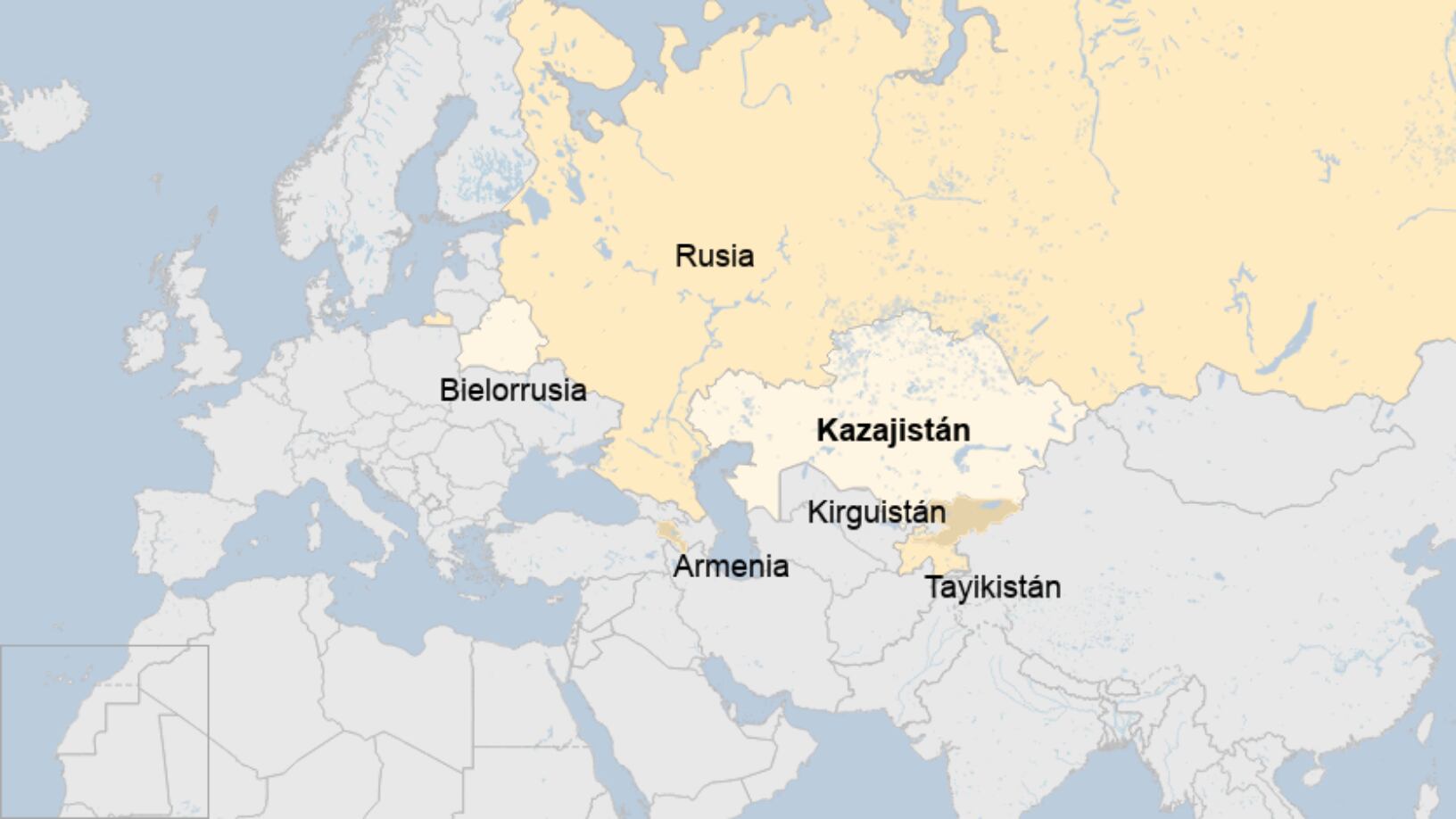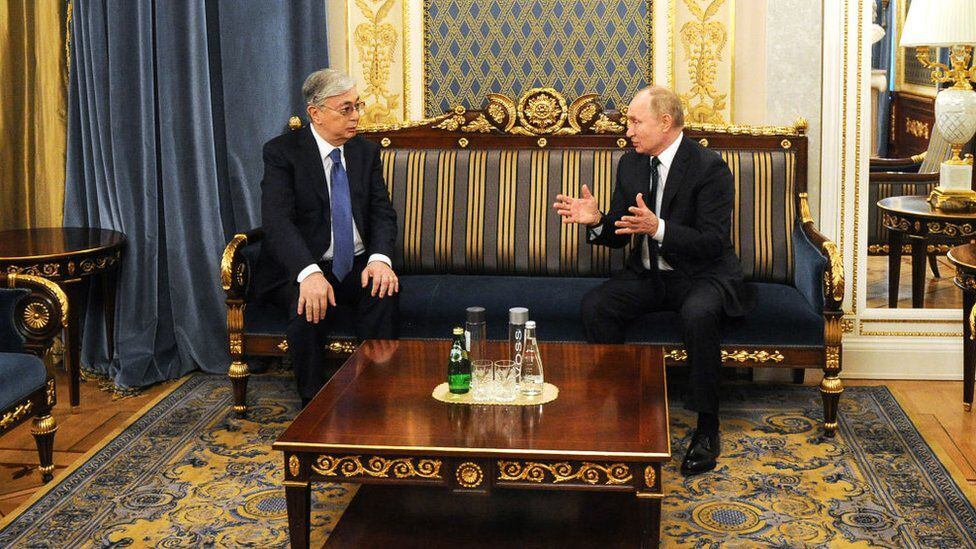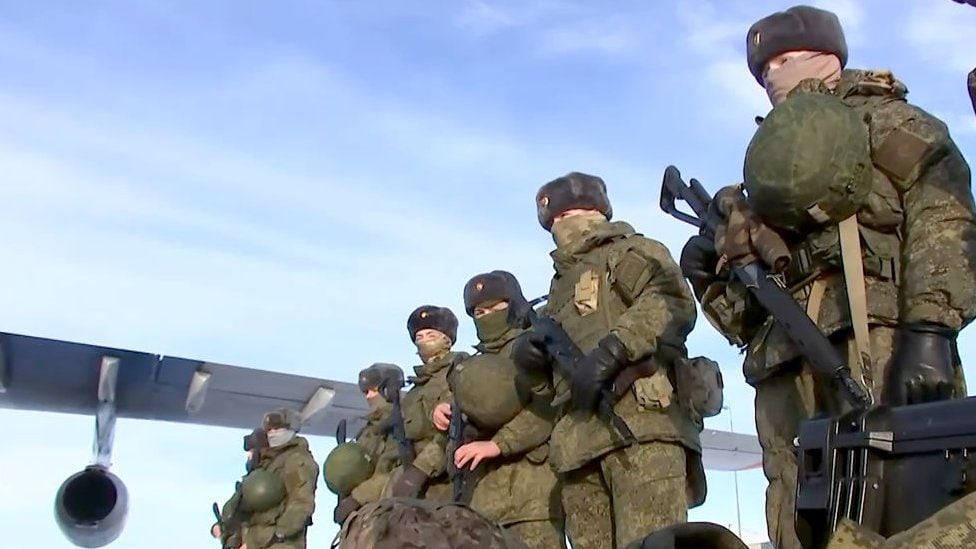The Warsaw Pact, an alliance of eight socialist nations, was for several decades the Soviet Union’s response to NATO, the Western military union.
But the fall of the socialist superpower and the end of the Cold War also meant the dissolution of that military cooperation agreement that had been signed in 1955 by the Eastern Bloc countries.
LOOK: Protests in Kazakhstan: “It looks like something out of an apocalyptic movie”
Nevertheless, it took less than a year in creating another alliance.
On May 15, 1992, six former Soviet nations (Russia, Armenia, Kazakhstan, Kyrgyzstan, Tajikistan, and Uzbekistan) signed a new pact, the Collective Security Treaty, which would later be joined by Azerbaijan, Belarus and Georgia.
- Why Russia got involved in the Kazakhstan conflict by sending government support troops
- The reasons behind the massive protests in Kazakhstan why Putin has sent troops to support the government
- Brutal order: President of Kazakhstan calls for “shoot to kill” protesters
Thus, the Collective Security Treaty Organization (CSTO) was born, a project smaller and much less powerful than the Warsaw Pact.
Almost three decades later, the military alliance rises to prominence at a time of high tension in Central Asia.
Since last Sunday, Kazakhstan, one of its founding members, has been going through a intense wave of protests which has left “dozens” dead and hundreds injured.
The trigger was the rise in the prices of liquefied petroleum gas by the government, which resulted in an increase in consumer prices, although behind it there are also other political reasons in a country classified as authoritarian and in which there is no opposition. effective to the government.
This Friday, the country’s authoritarian leader, Kasim-Yomart Tokaev, said that he had ordered the security forces to “shoot without warning“, amid a violent crackdown on protests.
Tokaev also reported that “20,000 bandits” had attacked the country’s main city, Almaty, which has become the epicenter of the conflict.
He has also branded them as “terrorists” trained abroad, without giving proof of this.
According to the Interior Ministry, 26 “armed criminals” and 18 security agents have been killed so far.
The equivalent of NATO in Central Asia
Faced with the critical situation, Tokaev requested the intervention of the CSTO to help his country’s forces to contain the protests.
Shortly after, a group of Russian troops landed in the country to “stabilize” the situation.

Currently, the alliance is made up of six former Soviet nations: Armenia, Belarus, Kazakhstan, Kyrgyzstan, Russia, and Tajikistan.
“Led by Russia, the CSTO is the region’s equivalent of NATO,” Kate Mallinson, an expert on Central Asia and the Soviet Union at the Chatham House institute in London, tells BBC World.
The British analyst assures that, after the treaty entered into force in 1994, it was seen as a “quackery for many years“, even after properly becoming a military alliance.

A “facade”
Although the current military intervention in Kazakhstan, formally at least, was carried out by the CSTO, Professor Neil MacFarlane, a specialist in Russian foreign policy and the regional dynamics of the former Soviet Union, points out that the operation was actually carried out by Moscow and defines the alliance as a “facade”.
“This organization has been around for several decades and never really done anything, apart from some exercises, “the expert tells BBC Mundo.
“It is a very biased organization. Russia derives some modest benefits from it, but not many. Until an event like the current one happens and it serves to intervene and repress internal dissent with the help of this multilateral facade.”
CSTO members enjoy cooperation with Russia’s sophisticated armed forces, and benefits such as the sale of used weapons and training.

For Kate Mallinson of Chatham House, Russia uses the CSTO to justify military installations in its member countries, while gaining veto power over any other foreign base in the region.
The expert assures that the club’s ambitions have grown in recent decades, with the creation of peacekeeping forces in 2007 and rapid reaction forces in 2009. made up of 20,000 elite troops, according to the organization.
“Last year, the alliance raised its profile when it conducted joint counterterrorism drills in reaction to the unrest in Afghanistan,” Mallinson adds.
In addition, he points out that the treaty is useful for Russia, because it gives importance and trust.
“Russia feels more secure as a global military player, due to its supposed successes in Ukraine and Syria.”
The first and only intervention
Until this week, the alliance had never intervened to resolve a crisis.
In 2010, Russia rejected a request from Kyrgyzstan for the CSTO to send peacekeepers to that country when a wave of ethnic violence broke out there, claiming it was an internal affair.
The organization also did not intervene during the massive protests against the regime of Alexander Lukashenko in Belarus in 2020.
So why do you do it now?
For Professor Neil MacFarlane there are several reasons, one of them is geopolitical: Kazakhstan has one of the longest land borders in the world and it has it with Russia.

“Russia is very careful about what happens on this long and defenseless border, but it is also concerned that this incident in Kazakhstan could promote terrorist activities in the region, where terrorist attacks have occurred in the past,” he adds.
“And another factor may be that Russia does not like Kazakhstan’s multipolar diplomacy and wants it to move a little closer to the Russian axis.”
“Happy Putin”
Kazakhstan is a huge country, the size of Western Europe, and it has some of the largest oil reserves in the world.
It produces 1.6 million barrels of oil a day, more than Colombia, Ecuador and Venezuela, but a large part of its population lives on little income.
According to analyst Kate Mallinson, President Vladimir Putin considered Nursultan Nazarbayev, who ruled Kazakhstan for 19 years until 2019, as one of its closest allies and is determined to avoid another “color” revolution in the post-Soviet space.

“Tokaev needed support to quell the opposition and Putin was more than happy to send Russian troops to its neighbor to the south “, assures the expert in Central Asia.
Professor Neil MacFarlane doubts that the organization will ever be as relevant as the Warsaw Pact or as NATO.
“The organization only works when Russia needs it. When Kyrgyzstan needed it, what happened? Any. (Former Russian president) Dmitry Medvedev said on that occasion that the CSTO was not to intervene in internal affairs, but how is the current situation different? “
MacFarlane says he doesn’t anticipate what might happen to the alliance, but remembers that it has been losing members for decades.
Azerbaijan, Georgia and Uzbekistan, three former members of the pact, abandoned it.
“If the CSTO was ever a multilateral organization, lately it looks more and more like a Russian instrument of international politics,” he concludes.
_______________________________
- “You cannot vaccinate the planet every 6 months. It is not sustainable “
- America’s strategy to ride out the waves of coronavirus
- France identifies new variant of COVID-19 called IHU with 46 mutations
- The Bogdanoff brothers, the most famous twins in France, die of coronavirus six days apart
- Coronavirus: What is “flurone”, the strange picture of double infection that puts the world on alert
.

:quality(75)/cloudfront-us-east-1.images.arcpublishing.com/elcomercio/GE4TANZNGAYS2MBYKQYDAORRHE.jpg)

:quality(75)/cloudfront-us-east-1.images.arcpublishing.com/elcomercio/RWWG5HRU3BFNZKU5MLUF6ORLUQ.jpg)
:quality(75)/cloudfront-us-east-1.images.arcpublishing.com/elcomercio/G4XHMKTQDZCQ7BTHCGRN7XOB5E.jpg)
:quality(75)/cloudfront-us-east-1.images.arcpublishing.com/elcomercio/DKUCOYMUDVAUTKR7OXTLV7WRKU.jpg)
:quality(75)/cloudfront-us-east-1.images.arcpublishing.com/elcomercio/6PBAAAQA4FE55BG3INTGETQ3RI.jpg)
